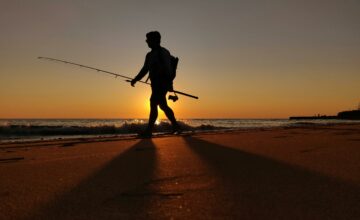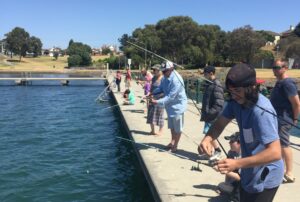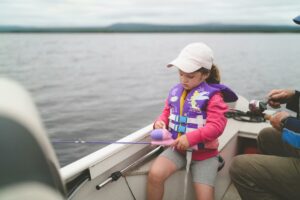May 22, 2015
by Matt Barwick, Recfishing Research
Studying fisheries can be tough. Someone once said “counting fish is just like counting trees… except they’re invisible and they move around a lot”. So, if counting fish is tough, spare a thought for the poor researchers whose job it is to count fishers…
At least a fish is always a fish… but is a fisher still a fisher when they pick up a golf club?
And the fun doesn’t stop once the counting is done, either. Once we know how many people are fishing, it’s often difficult for mangers to then know what to do with this information. Is the objective to grow the number of recreational fishers? If you were to ask the crowd of fishers on the Mordialloc Pier when the snapper, calamari and garfish are biting they might not think so!
Nevertheless, the benefits of growing the population of Australian fishers are clear. In 2000, The National Recreational and Indigenous Fishing Survey (NRIFS) estimated that recreational fishing contributes approximately $1.8 billion to the Australian economy (and this figure is likely to be much higher today). More fishers = more economic growth. Additionally, fishing has been shown to provide a range of health and wellbeing benefits to those who participate. So perhaps in this era of growing obesity, heart disease and other lifestyle-associated health concerns, more people should be opening tackle boxes instead of pill boxes?
The Victorian Government’s ‘Target One Million’ program announced in the lead up to the 2014 election seeks to grow the economic and social benefits of fishing enjoyed by Victorians by increasing participation in fishing from 721,000 Victorians annually, to one million. Fortunately, the Program is based on a plan for increased investment in fishing infrastructure, stocking and artificial fish habitat to provide more fishing locations and better quality fishing experiences, so the folks on the Mordialloc Pier can continue to enjoy high quality fishing in relative peace.
Of course, the old adage rings true: you can’t manage what you can’t measure, and so there will continue to be a need to monitor the number of people fishing – both in Victoria, and other states and territories. If done right, future surveys will enable us to understand and deliver the sort of fishing experiences that people crave, whilst ensuring that management arrangements are appropriate.
What we know
We know that Australians have a long-lasting love affair with fishing. An estimated 3.36 million Australian residents aged 5 years or older fished at least once in the 12 months prior to May 2000 according to the last national survey. This represented a national recreational fishing participation rate of 19.5%. By international standards this highlights that we Aussies enjoy fishing more than most: on average across countries with reliable statistics, the participation rate is around 10% [2] (though we lag behind countries such as Norway where fishing participation can be as high as 32%).

Unfortunately, despite Australia’s long-lasting romance with fishing, there are signs that the honeymoon may be ending. A number of statewide surveys have been conducted since the national survey in 2000, and all have reported a decline in participation – in the case of South Australia and the Northern Territory, by more than 25% (see Table 1 below).
Table 1‘Best available’ recreational fishing participation estimates for residents of each jurisdiction in Australia. Source: Griffiths et al 2014
| State | Year | No. of Fishers | Nat Survey Estimate | Change in number | % change relative to 2000 |
| NT | 2010 | 31,790 | 43,932 | -12,142 | -27.64 |
| QLD | 2011 | 703,020 | 746,619 | -43,599 | -5.83 |
| NSW | 2000 | 998,501 | 998,501 | – | – |
| VIC | 2000 | 549,803 | 549,803 | – | – |
| TAS | 2008 | 118,300 | 125,017 | -6,618 | -5.29 |
| SA | 2008 | 236,463 | 328,227 | -91,764 | -27.95 |
| WA | 2000 | 479,425 | 479,425 | – | – |
We have a few clues regarding causes for declining participation in fishing too. A study by Dr Steven Sutton from James Cook University and his colleagues explored reasons why Queenslanders had ceased fishing, and reported that lack of time, loss of interest and poor fishing quality were driving factors[3]. Another study by Dr Jacki Schirmer from the University of Canberra found that South Australian fishers who reported that they fish less than they used to, cite lack of free time, poor weather, rising costs and poor quality fishing as key reasons[4]. Our time-poor predicament is supported by the Australian Bureau of Statistic’s 2006 time use survey, which reported that we are spending 1 hour and 45 minutes less time per week on recreation and leisure activities compared to 1997, and around 2 hours and 13 minutes extra working each week.
However this may not be the whole picture; in terms of how we are spending our remaining recreational time in 2006, it seems that we had increased our consumption of television and internet by almost exactly the same amount of time per week that we have reduced our time spent on sport and outdoor activities (around 1 hour). Imagine what percentage of our available time we must be investing in the consumption of electronic media as a nation today, in light of studies showing that our teenagers spend around four hours each day watching television[5], and the average Australian spends one minute in five using social media?[6]
Declines in fishing participation have also been reported in various parts of North America, Europe and Oceania, with studies linking declining participation to growing population density and gross domestic product. In short, as we lead more urban lifestyles and work harder, it seems fewer people are fishing[7].
When did we hold the meeting where we agreed to trade our time on the water with family and friends for hours spent blankly staring at a screen, whether for work or play? And what does this mean for our favored Australian pastime, or our relationship with our land and waterways and the farmers and fishers who utilise them to provide our food and natural fibres?
Fortunately some countries have managed to reverse this concerning trend. Canada’s Go Fish BCcampaign which aims to increase fishing participation in British Columbia has arrested a ten year trend of declining participation, with 6% more anglers reported in 2013 compared to 2005[8]. This has been the result of increased investment in fishing infrastructure, and programs to teach people to fish, including free rod, reel and tackle box loans. They’ve also introduced a novel ‘fishing buddies’ program, which encourages experienced fishers to introduce new or lapsed fishers to the joy of wetting a line. The development and promotion of ‘family fishing waters’, which are easily accessible and full of catchable fish has had a great impact too.
A study exploring reasons underpinning the reversal of a two-decade declining trend in fishing participation in the United States also reported an 11% increase in participation between 2006 and 2011[9]. Reducing fishing license prices was shown to positively influence participation, as did investment in programs to introduce people to fishing, and increase retention of those already fishing. Interestingly, there also appeared to be a correlation between the recent increase in fishing participation, and a decline in the number of new building permits issued. Basically, the economic downturn experienced during the Global Financial Crisis appeared to enable more tradies to spend their newfound free time fishing… Finally a silver lining! There also appeared to be a trend of more people searching for natural food sources, and choosing to harvest fish themselves for this purpose.
We can learn a few important lessons from this brief scan of trends in fishing participation and underpinning drivers around the world. Countries that have made a commitment to re-connect their communities with fishing show us that it’s not too late. Programs seeking to introduce or re-acquaint people with fishing, and improve the quality of fishing experiences available play a vital role in successfully building fishing participation. This augurs well for outcomes likely to be delivered from initiatives such as Victoria’s ‘Target One Million’ program and South Australia’s recently announced Recreational Fishing Grants Program. Also clear, is the need for continued investment in long-term monitoring to track what recreational fishers are catching, how often they are fishing, what they think of their fishing experiences, and what they do when they’re not fishing. This will ensure that we continue to deliver fishing experiences that Australians desire, to keep them connected to our rivers and oceans, and the benefits that fishing provides. And maybe even return the television in its rightful place in the home: In the corner, and infrequently used.
[1]Mcmanus, A., Hunt, W., Storey, J., White, J., 2011. Identifying the health and well-being benefits of recreational fishing. Tasmanian Aquaculture and Fisheries Institute, Final report for FRDC project 2011/217.
[2]http://www.fecpl.ca/wp-content/uploads/2013/06/Arlinghaus_Cooke_2009.pdf
[3]http://www.researchgate.net/profile/Stephen_Sutton2/publication/233288124_Why_Do_People_Drop_Out_of_Recreational_Fishing_A_Study_of_Lapsed_Fishers_from_Queensland_Australia/links/541c35f80cf203f155b36d4d.pdf
[4]http://recfishingresearch.org/wp-content/uploads/2014/06/2013-Presentation-Social-Benefits-of-Fishing-Jacki-Schirmer.pdf
[5]http://www.acma.gov.au/webwr/_assets/main/lib310665/no1_internet_use_social_networking_young_people.pdf
[6]https://www.pria.com.au/industrynews/13-million-australians-spend-18-hours-a-day-online
[7]http://onlinelibrary.wiley.com/doi/10.1111/fme.12075/abstract
[8]http://www.gofishbc.com/docs/default-source/economic-analysis/2013_bc_freshwater_sport_fishing_economic_impact_report.pdf?sfvrsn=2
[9]http://www.responsivemanagement.com/download/reports/Hunt_Fish_Increase_Report.pdf








